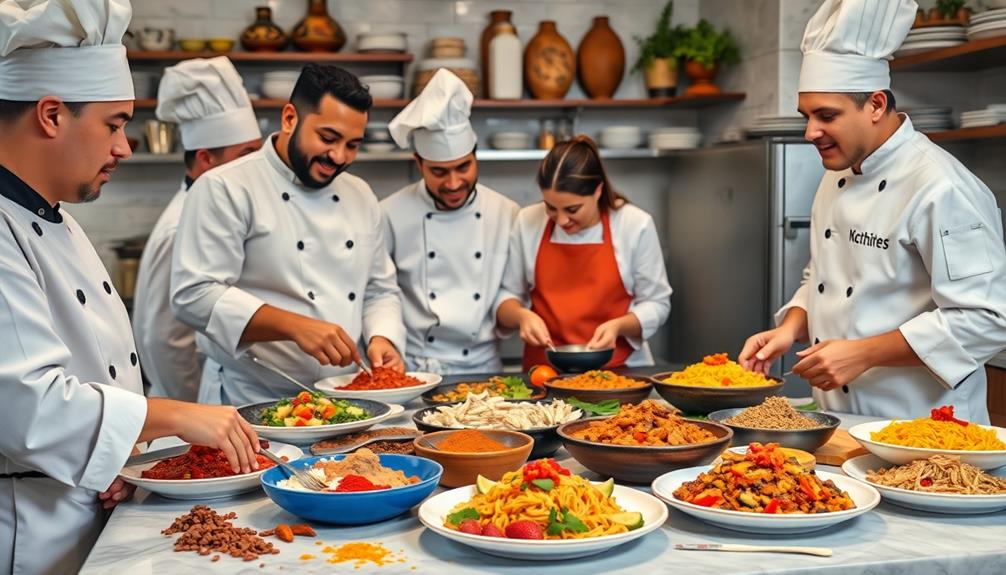Cultural fusion is revolutionizing modern cuisine, mixing flavors from around the globe to create exciting new dishes. You'll find everything from Korean tacos to sushi burritos on menus, reflecting a blend of culinary traditions. This fusion emphasizes creativity while honoring the roots of each culture, ensuring authenticity and respect are maintained. Globalization and social media boost these trends, making diverse ingredients and techniques more accessible than ever. As chefs experiment with bold combinations and innovative cooking methods, you'll discover a vibrant culinary landscape that continues to evolve. There's so much more to explore about these delicious transformations!
Key Takeaways
- Fusion cuisine creatively blends diverse culinary traditions, resulting in innovative dishes that honor and respect original flavors and techniques.
- Globalization and social media facilitate the exchange of culinary practices, inspiring adventurous dining experiences and unique flavor combinations.
- Cultural sensitivity is essential in fusion cooking to prevent appropriation and ensure authenticity in dishes representing diverse culinary identities.
- Innovative culinary techniques, such as molecular gastronomy and fermentation, enhance traditional dishes and expand flavor profiles in modern cuisine.
- Third-culture cuisine reflects America's cultural diversity, merging global flavors and appealing to contemporary dining preferences for multicultural experiences.
Understanding Fusion Cuisine
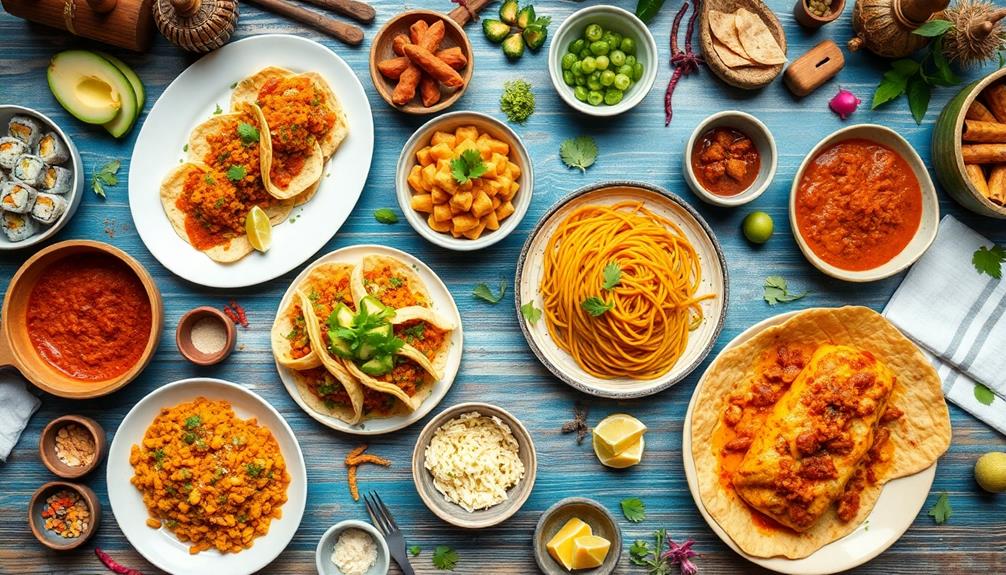
Fusion cuisine blends diverse culinary traditions, creating a dynamic and innovative dining experience. You'll find that it emphasizes creativity and intentional flavor pairing, rather than just randomly mixing ingredients. For instance, dishes like Gobi Manchurian showcase the exciting combination of Indian and Chinese flavors. This approach respects the essence of cultural fusion, allowing you to explore exciting new flavor profiles while honoring the roots of each culinary tradition involved.
Historically, fusion cuisine has deep roots, but it gained significant traction in the 1980s with chefs like Roy Yamaguchi and Wolfgang Puck, who introduced terms such as Pan-Asian and Cal-Asian.
As you immerse yourself in this world, it's vital to maintain cultural sensitivity. Understanding the original culinary techniques and ingredients prevents cultural dilution and appropriation, ensuring you appreciate the heritage behind each dish.
Today, culinary education reflects this trend, emphasizing both traditional and modern methods to prepare students for innovative practices. With ongoing globalization, you can expect fusion cuisine to evolve further, introducing new flavor profiles and sustainable practices, all while celebrating diverse culinary heritages.
Historical Context of Fusion
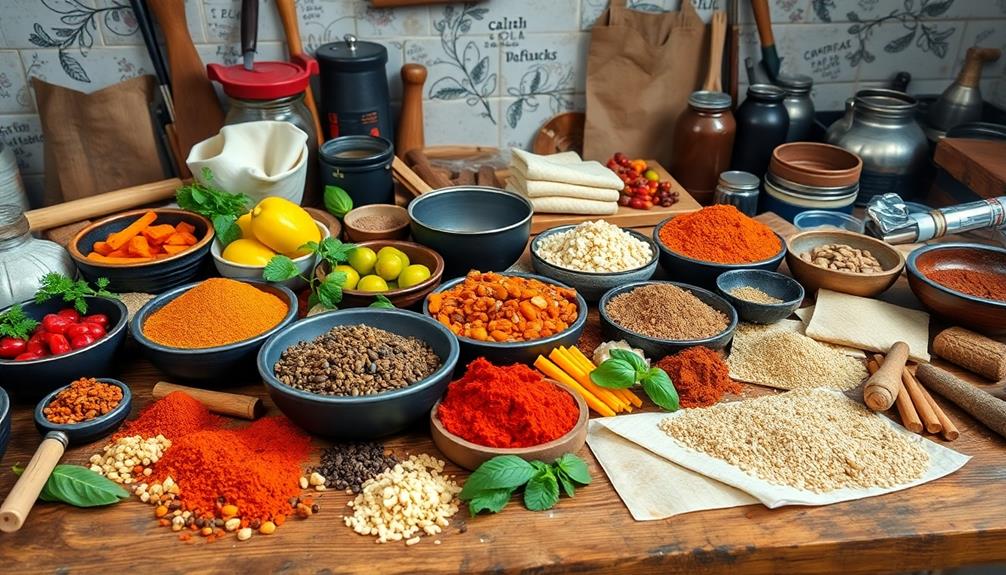
Throughout history, culinary practices have evolved through trade, migration, and cultural exchange, setting the stage for what we recognize today as fusion cuisine. For instance, the introduction of flavors like Sichuan Cold Noodles showcases how different regions combine distinct ingredients and methods.
You can trace its historical roots back centuries, with early examples like Italian spaghetti, which was influenced by Chinese noodles. This blending of culinary traditions laid the groundwork for the more modern interpretations of fusion that emerged in the 1980s. Chefs like Roy Yamaguchi and Wolfgang Puck began to experiment, combining different elements to craft innovative dishes that captivated diners.
As culinary globalization accelerated, the popularity of fusion cuisine surged in the 1990s. Terms like Pan-Asian and Cal-Asian sprang up, describing distinctive styles that integrated multiple cultural influences into cohesive culinary experiences.
However, this rise wasn't without its challenges. Some poorly executed combinations gave rise to the term "con-fusion," critiquing the unsatisfactory outcomes of hasty fusion attempts.
Still, the ongoing exchange of practices and ingredients across various cultures continues to shape the evolution of fusion cuisine, reminding you that food is a reflection of the interconnectedness of our world.
Cultural Sensitivity in Cooking

Cultural sensitivity in cooking is essential for creating dishes that honor the origins of diverse culinary traditions. For instance, incorporating unique elements from traditional Japanese cuisine, such as the use of sweet red bean paste in Dorayaki, can enhance fusion dishes while respecting their roots.
When you embrace this sensitivity, you prevent cultural dilution and appropriation, guaranteeing that each dish reflects its roots authentically. Understanding the ingredients and techniques of various cuisines allows you to craft fusion cuisine that celebrates diversity while respecting its origins.
Successful fusion cuisine strikes a balance between innovation and homage. You must guarantee that the original culinary identities remain intact, even as you blend flavors and techniques. This requires a thoughtful approach, where you recognize the significance of traditional dishes and the stories behind them.
Culinary education increasingly emphasizes cultural sensitivity, equipping aspiring chefs like you with the tools to navigate the complexities of global culinary landscapes responsibly. Engaging with local communities and their culinary practices deepens your appreciation for the cultural significance inherent in traditional dishes.
Global Influences on Dishes
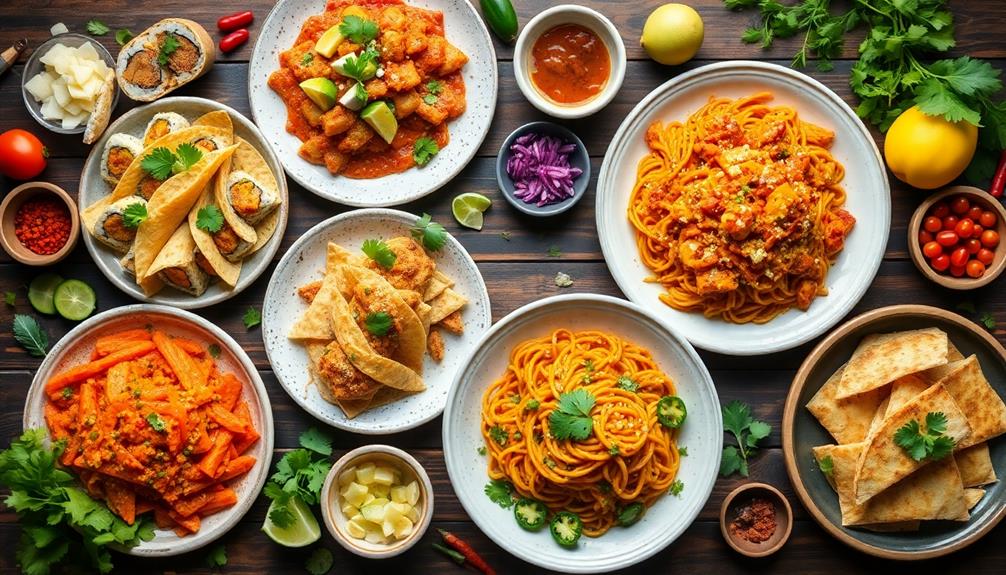
As you embrace cultural sensitivity in your cooking, you'll notice how global influences shape the dishes you create. The rise of globalization has made it easier than ever to exchange culinary practices, resulting in fusion cuisine that incorporates elements from multiple cultures.
Think about the popularity of sushi burritos or kimchi tacos; these dishes highlight the creative possibilities that arise when diverse flavor combinations come together. For instance, the incorporation of Mexican street food flavors into various dishes can lead to exciting new culinary experiences.
Social media plays a significant role in amplifying these global influences. Chefs showcase their innovative dishes online, inspiring home cooks like you to experiment with new ingredients and techniques.
Ethnic restaurants have also introduced a wider audience to global flavors, making ingredients like sriracha and soy sauce staples in many American kitchens.
Culinary festivals celebrate fusion dishes, allowing chefs to experiment with flavors from various backgrounds and cultures. As you explore international cuisines, you'll find that your adventurous palate welcomes these diverse flavor combinations.
Increased travel and exposure to different culinary traditions encourage you to seek out and embrace this vibrant tapestry of tastes, enriching your own cooking experience while honoring the cultures that inspire you.
Popular Fusion Trends Today
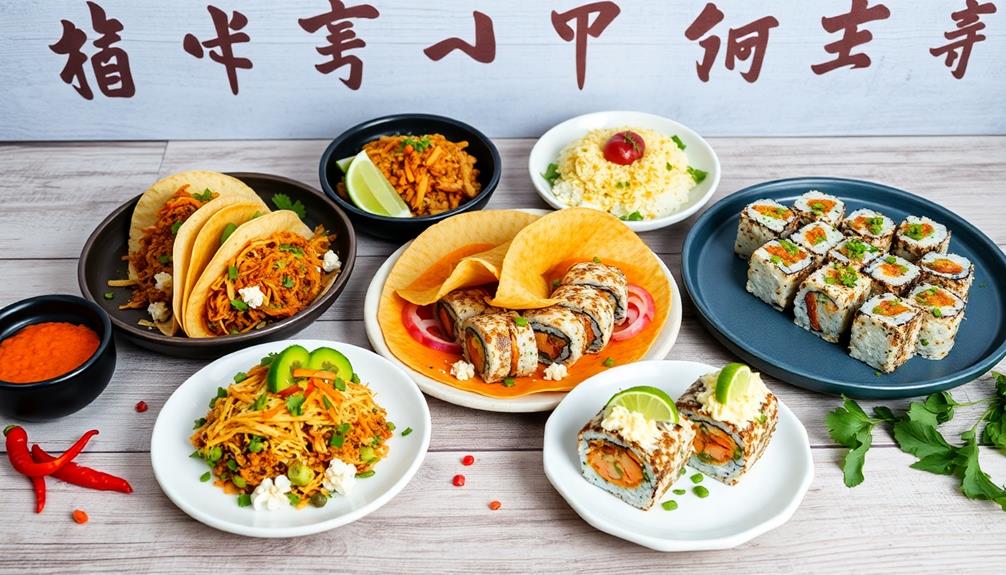
You've probably noticed the explosion of global flavor combinations in today's dining scene, from Korean tacos to Japanese-Peruvian ceviche.
Innovative culinary techniques are reshaping traditional dishes, making them more exciting and accessible. For instance, dishes like bulgogi tacos showcase the savory marinated beef in a handheld format, appealing to a diverse audience.
Let's explore some of the most popular fusion trends that are enchanting food lovers everywhere.
Global Flavor Combinations
Today, countless food enthusiasts are diving into the exciting world of global flavor combinations that define modern fusion cuisine. You might be intrigued by popular dishes like Korean-Mexican tacos, which blend spicy kimchi and bulgogi with traditional taco elements. This adventurous melding of culinary traditions appeals to those seeking bold flavors.
The rise of mash-up cuisine is also hard to ignore. Unique creations like the Cronut® and ramen burgers showcase how distinct food concepts can come together for delicious results. Asian fusion flavors have gained traction, merging diverse culinary traditions from Asia with global elements to craft unforgettable taste experiences.
Social media plays a significant role in this trend, amplifying the visibility of creative dishes. Food trucks, in particular, lead the charge, attracting younger audiences enthusiastic to try innovative combinations. Additionally, ingredients like sriracha and miso have become household staples, pushing fusion cuisine into the mainstream.
Here's a quick look at some popular global flavor combinations:
| Dish | Key Ingredients | Culinary Influence |
|---|---|---|
| Korean-Mexican Tacos | Kimchi, bulgogi, tortillas | Korean, Mexican |
| Ramen Burgers | Ramen noodles, beef patty | Japanese, American |
| Cronut® | Croissant, donut | French, American |
| Sushi Burritos | Sushi rice, fresh vegetables | Japanese, Californian |
Innovative Culinary Techniques
Innovative culinary techniques are revolutionizing fusion cuisine, pushing the boundaries of traditional cooking methods. As you investigate this dynamic world, you'll discover how chefs blend science with artistry to create dishes that tantalize the palate.
For instance, Brazilian cuisine showcases a rich cultural fusion of indigenous, African, and Portuguese flavors, which can inspire unique culinary creations. Here are some popular trends shaping modern fusion food:
- Molecular Gastronomy: Chefs manipulate textures and flavors using scientific methods, transforming how you experience food.
- Sous-Vide Cooking: This technique guarantees precise temperature control, resulting in perfectly cooked proteins infused with global spices.
- Cross-Cultural Grilling: Methods like Korean BBQ and Argentine asado bring communal dining to the forefront, merging traditional flavors in exciting ways.
- Fermentation: Incorporating ingredients like kimchi or miso adds depth and complexity, enhancing umami profiles while offering health benefits.
These innovative culinary techniques allow you to savor complex flavors and engage with food in ways you've never imagined.
The artistic presentation inspired by Japanese aesthetics further elevates your dining experience, turning each dish into a visual masterpiece. As you explore fusion food, you'll appreciate the creativity and skill behind each bite.
Third-Culture Cuisine Explained
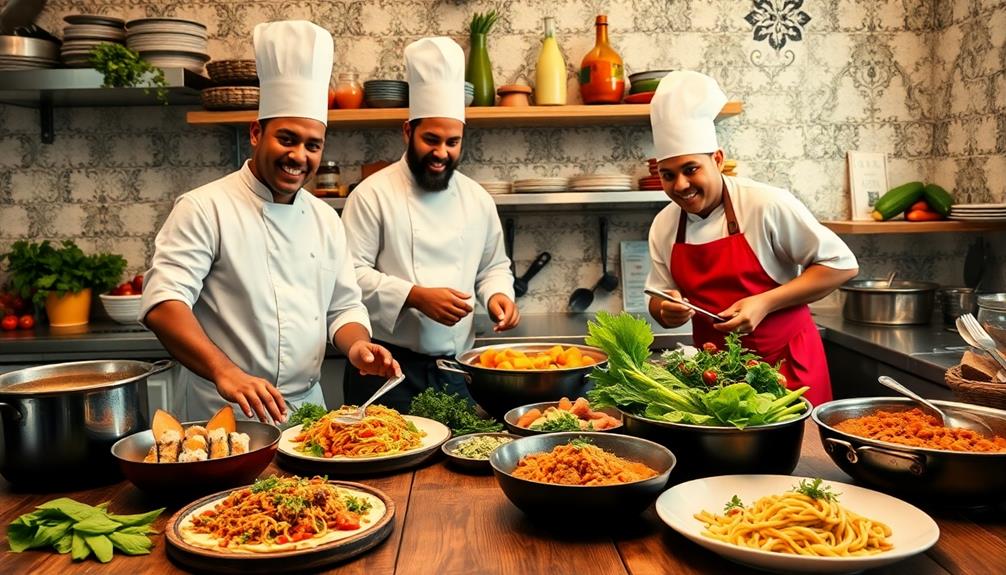
Third-culture cuisine is a vibrant culinary movement that blends diverse culinary traditions, reflecting America's rich tapestry of cultural influences. This fusion cuisine thrives on the merging of flavors from different cultures, showcasing the creativity and innovation of chefs who experiment with ingredients and techniques from around the globe.
For instance, you might encounter dishes inspired by Thai street food such as a spicy sausage blended with Mexican spices, illustrating the seamless integration of global culinary practices. As you explore this trend, you'll discover popular dishes like Korean-Mexican tacos and Japanese-Peruvian ceviche. These dishes highlight how culinary traditions can intertwine to create something entirely new and exciting.
The rise of third-culture cuisine indicates a shift in dining preferences. You're likely seeking bold flavors and diverse culinary experiences that celebrate multicultural influences. By embracing this trend, restaurants can differentiate themselves, offering unique dining experiences that resonate with adventurous eaters.
They can promote authenticity and leverage technology to engage customers, creating buzz around their innovative offerings.
In this ever-evolving culinary landscape, third-culture cuisine not only satisfies your taste buds but also reflects the cultural diversity that shapes modern America.
Innovative Dishes and Mash-Ups
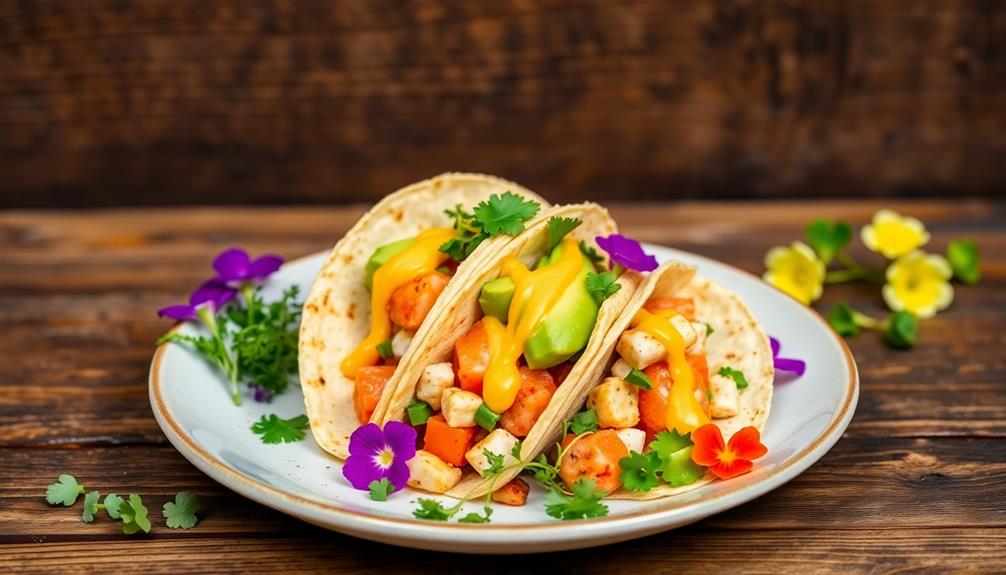
You've probably seen some incredible mash-ups like the Cronut® or ramen burger that combine unique flavors into unforgettable dishes.
These innovative creations not only reflect cultural influences but also spark trends that keep your taste buds excited.
For instance, the incorporation of traditional desserts like Kue Putu showcases how diverse ingredients can come together to create new experiences.
Let's explore how these culinary combinations are reshaping what we eat today.
Creative Flavor Combinations
In today's culinary landscape, creative flavor combinations are transforming how we experience food. Fusion dishes have taken center stage, inviting adventurous eaters to explore exciting new tastes. One standout example is the Korean-Mexican taco, which blends spicy kimchi and bulgogi with traditional taco elements. This mash-up is just one of many innovative dishes capturing attention.
Vietnamese cuisine also showcases unique flavor profiles, such as the cylindrical sticky rice cake, which offers a chewy texture and subtle sweetness that can inspire modern twists on traditional dishes.
Social media has fueled this trend, allowing chefs to showcase unexpected flavor pairings and influencing dining experiences worldwide. Here are some key aspects of these creative flavor combinations:
- Unusual pairings, like the Cronut® (a donut-croissant hybrid) and ramen burger, provide playful culinary exploration.
- Quick-service restaurants (QSRs) embrace novelty with items like waffle tacos, although concerns about quality can arise.
- Asian flavors, such as sriracha and miso, have entered mainstream cuisine, enriching traditional dishes with depth.
- The excitement of trying new flavors encourages a sense of adventure and curiosity in diners.
As you explore modern cuisine, keep an eye out for these innovative mash-ups that push boundaries and redefine your palate.
Iconic Mash-Up Examples
Culinary mash-ups have taken the food world by storm, showcasing innovative dishes that delight adventurous eaters. Iconic examples like the Cronut®—a delightful hybrid of a donut and croissant—have captured widespread attention, while the ramen burger combines savory ramen noodles with a juicy burger patty, creating an exciting culinary experience.
Chefs are now incorporating fresh, seasonal ingredients into these mash-ups, elevating the flavor profiles and nutritional value of their creations, such as dishes inspired by farm-to-table cooking.
Korean tacos represent another flavorful fusion cuisine, blending spicy kimchi and bulgogi with traditional taco elements. This mash-up caters to those seeking bold flavor combinations that push culinary boundaries.
Similarly, the rise of the waffle taco, a unique breakfast option, offers a fun twist on quick-service dining, inviting customers to enjoy their morning meal in a new way.
Not to be overlooked, sushi burritos provide a portable option that marries the elegance of sushi with the convenience of a burrito, reflecting the growing demand for innovative dining experiences.
While these mash-ups often prioritize novelty, chefs are increasingly focusing on maintaining quality and harmony in flavor pairings. By balancing creativity with taste, these dishes exemplify how fusion cuisine can excite and satisfy the modern palate.
Cultural Influence on Trends
Food trends today thrive on cultural influences that spark creativity in the kitchen. You can see this in the rise of innovative dishes that blend cultural traditions and offer exciting new flavors.
As chefs experiment with fusion cuisine, mash-ups like the Cronut® and ramen burger capture our attention and taste buds. Food trucks have also played a significant role, showcasing unique combinations like Korean tacos that merge Korean and Mexican street food.
Here are some key ways cultural influences shape culinary trends:
- Social Media Power: Platforms amplify visibility, allowing chefs to share their creative mash-ups with a global audience.
- Culinary Education: Schools now teach fusion cooking, equipping aspiring chefs to innovate while respecting diverse traditions.
- Third-Culture Cuisine: Dishes like Japanese-Peruvian ceviche highlight new flavor profiles, blending fresh seafood with citrus and umami.
- Increased Experimentation: Chefs are encouraged to think outside the box, embracing unexpected ingredients to create memorable dining experiences.
Culinary Education's Role
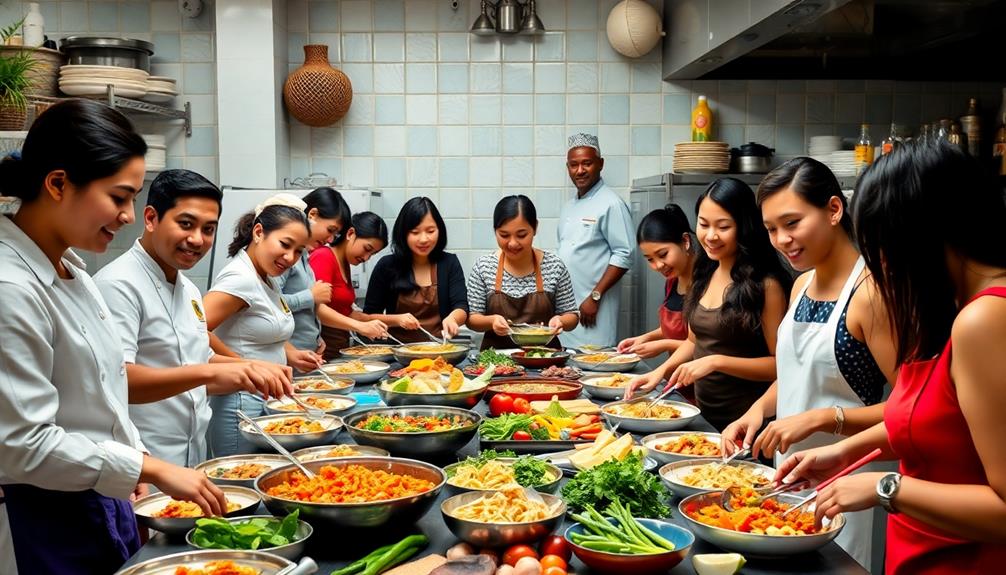
As culinary schools adapt to the evolving landscape of modern cuisine, they play an indispensable role in shaping future chefs. You'll find that many programs now emphasize fusion cooking techniques, merging traditional and modern culinary methods. This approach prepares you for a diverse food landscape, where innovation and creativity are vital.
Courses often highlight global cuisine trends, teaching you the cultural significance and techniques behind various cooking styles. You're encouraged to experiment with innovative flavor pairings, all while respecting and understanding the original cuisines you draw from. This balance fosters a deeper appreciation for culinary heritage and promotes creativity in your dishes.
Collaborations between culinary schools and diverse cultural chefs further enhance your education. These partnerships expose you to global practices and instill cultural sensitivity in your approach to fusion cooking.
Additionally, with the rise of social media and food blogging, culinary education now incorporates digital storytelling and marketing strategies. This guarantees you can effectively promote your fusion creations in today's digital age.
In essence, culinary education is evolving to equip you with the skills and knowledge to thrive in a world where culinary fusion is increasingly celebrated.
Future Directions of Fusion Cuisine

The evolution of culinary education sets the stage for an exciting future in fusion cuisine. As you explore the world of flavors, you'll notice key trends shaping what's to come. The emphasis on sustainability and health will lead to more plant-based dishes, reflecting consumers' priorities. Globalization will continue to blur culinary boundaries, inviting you to experience new flavor profiles.
Here are some future directions to reflect upon:
- Plant-based innovation: Expect exciting ingredients that cater to health-conscious diners while preserving flavor.
- Culinary tourism: Adventurous eaters will seek diverse fusion experiences, pushing chefs to create dishes showcasing cultural intersections.
- Technology's role: Social media will enable chefs to share and experiment with fusion recipes, democratizing culinary creativity.
- Heritage exploration: Chefs will honor traditional techniques, blending them with modern interpretations to enrich fusion gastronomy.
As you engage with these developments, you'll discover that the future of fusion cuisine isn't only about diversity and innovation but also about the stories and cultures behind each dish.
Embrace this culinary adventure; it's bound to be delicious!
Frequently Asked Questions
How Does Culture Influence the Cuisine of a Country?
Culture shapes a country's cuisine by introducing unique ingredients and cooking methods. You experience diverse flavors and dishes that reflect historical influences and community traditions, enriching your culinary journey with every bite you take.
What Is the Significance of Fusion Cuisine?
Fusion cuisine's significance lies in its creativity and ability to blend diverse flavors, enriching your culinary experience. It encourages experimentation, celebrates cultural diversity, and keeps you engaged with global food trends, making every meal an adventure.
What Are the Cultural Roots to Fusion Cuisine?
Imagine vibrant markets filled with spices, aromas swirling around you. Fusion cuisine's roots lie in centuries of trade and travel, where cultures blended, creating unique dishes that tell stories of connection and culinary adventure waiting for you to explore.
What Is Cultural Fusion in the Field of Food?
Cultural fusion in food combines culinary traditions from different cultures, creating innovative dishes. You'll find diverse ingredients and techniques blending together, resulting in unique flavors that celebrate global influences and enhance your dining experience.
Conclusion
In the kitchen, each ingredient symbolizes a unique culture, blending together to create a tapestry of flavors. As you experiment with fusion cuisine, remember that every dish tells a story, celebrating diversity while respecting traditions. Like a vibrant mosaic, modern cuisine thrives on these connections, inviting you to explore and innovate. Embrace the journey of culinary exploration, and let your palate reflect the world's rich tapestry, where every bite is a bridge between cultures.
